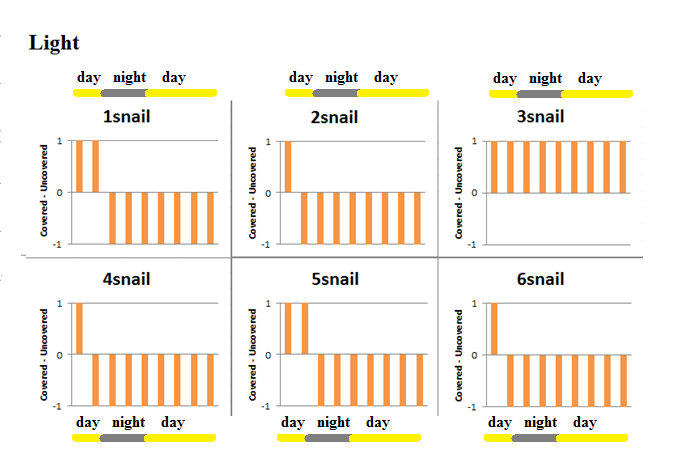Behaviour
Activity Behavior
Introduction
A huge number of mollusks seems to have their activities determinated by biotic or abiotic factors. For example, the attempt to avoid predation from marine carnivorous animals might lead them to be more active during the low tide (Little, C., 1989). As well as places with high densities of individuals can determine preference for feeding during the day, while to avoid desiccation the night would be the best time to activity (Little, C., 1989). With this background, the aim of our project was to try to see patterns of activity time in three different situation.
Material & Methods
The experiment was conduced from thrusday to Friday (26,27/09) at the Research Station on Heron Island. The lowest tides at thrusday,26/09, were at 6:24 (0.8m) and at the 20:16 (1.0m), and the highest at 13:20(2.1m). At Friday, 27/09, the lowest tides were at 7:43 (1.0) and at 21:51(1.0m) at the highest tides at 02:01 (1.5) and at 14:41 (2.0m) (Figure 4).

Figure 4. Tide variation during the time that the experiment was conduced.
At our project, we had three different treatments-Control, light and dark. For all of them we had six individuals placed each onein a distinct aquarium, which had half of it with rocks- the covered side- andthe other half with sand- uncovered side. Every aquarium had a constanct flowof salt water. At the control, these aquariuns were kept outside thelaboratory, subjected to the natural light cycles. The aquariuns for the lighttreatment stayed inside the wet laboratory, where the artificial lights wereturned on during all the experiment. And the dark treatment had those aquariunsinside the wet lab either, but with a black plastic covered them the entiretime. The position of the mollusks into the tanks were checked every fourhours; when the snail was under the rocks, we noted as covered (C), and when itwas at the sand, we noted as uncovered (UC). The data of each snail was putinto graphics presented bellow.
Results

Figure 5. Position of each of the six snails during the experiment at the Control.

Figure 6. Position of each of the six snails during the experiment at the Light treatment.

Figure 7. Position of each of the six snails during the experiment at the Dark treatment.
Observing the total time uncovered or covered, we can note that the time under the rocks was higher than the time uncovered in all the treatments. Although, we could not find any visible relation between the light exposure for these mollusks activity. At the control, in 10% of the time the snails were exposed (Figure 5), at the light treatment (Figure 6), during 20% of the time, and at the dark control (Figure 7), during 23% of the time. Even with no visible variation among the treatments, we can note different individuals behavior between the snails.
As herbivorous animals, it was expected that they would stay more time around the rocks, since some algaes keep attached to it. However, the few number of individuals, as well as the little observation time might have represented restraints for the research. |